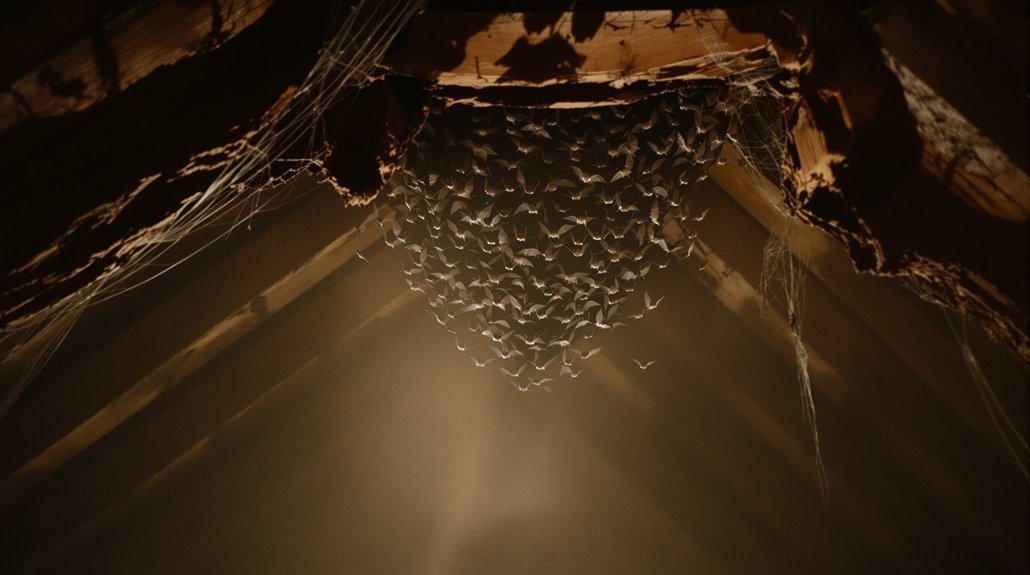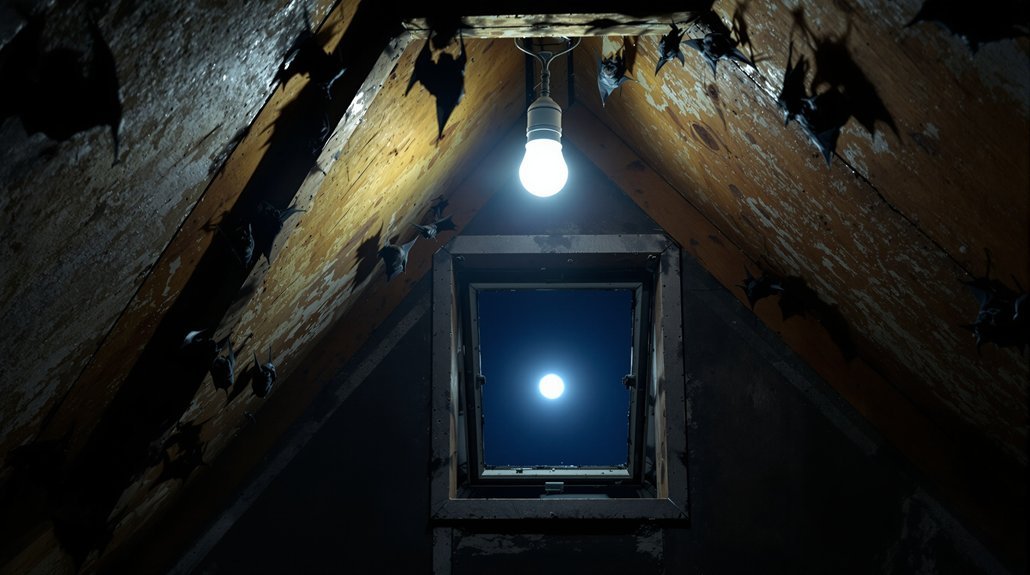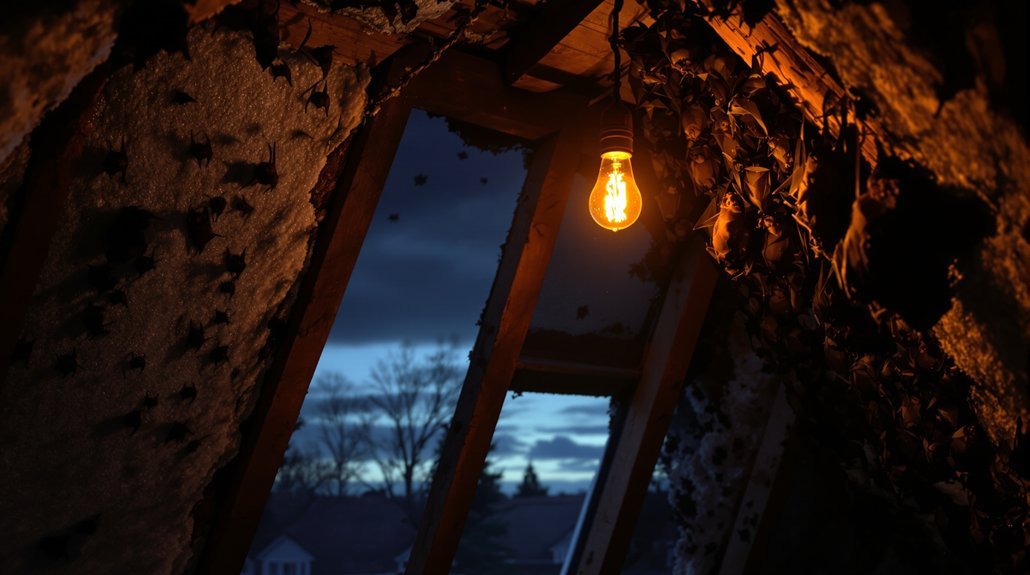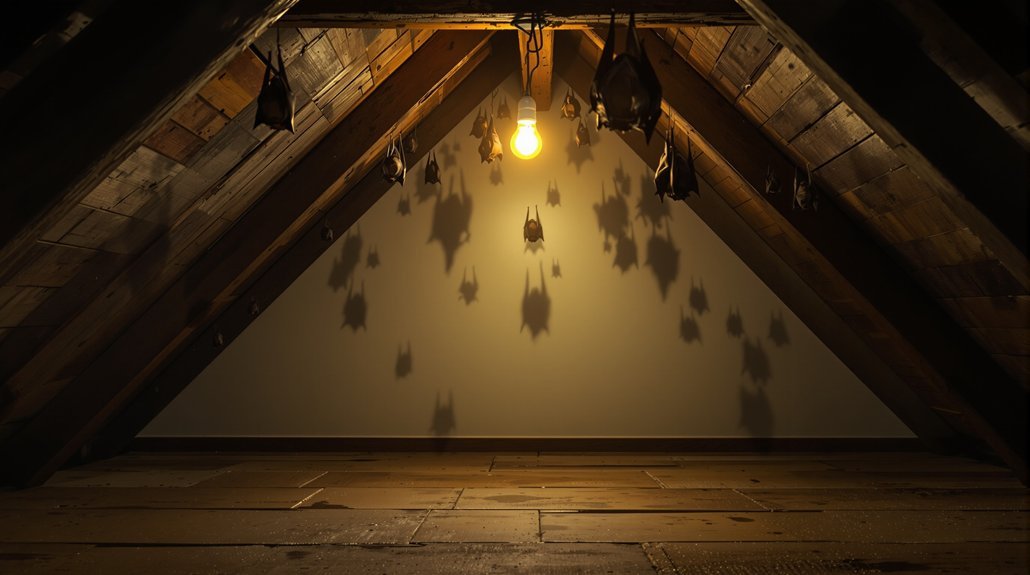Leaving a light on in the attic will not effectively get rid of bats in Des Moines. Bats are not scared of bright lights and may even be attracted to them because of the insects they draw. Light can disrupt their natural behavior but does not serve as a true deterrent. For better results, it’s important to contemplate other methods for bat removal and prevention. There are more effective ways to handle bat issues that you can explore.
Key Article Highlights
- Leaving a light on in the attic is ineffective for driving bats away; they may prefer dark environments for roosting.
- Bats can be attracted to lights due to insect activity, potentially complicating efforts to deter them.
- Proper bat control involves sealing entry points and using one-way doors, rather than relying on lighting as a deterrent.
- DIY light-based methods may lead to health risks and ineffective long-term results, making professional removal preferable.
- Regular inspections and habitat modification are essential for preventing future bat infestations, rather than relying solely on illumination.
Understanding Bat Behavior

Although bats are often misunderstood creatures, their behavior plays a essential role in how they interact with their environment. Bats typically inhabit dark and quiet spaces, making attics an ideal bat habitat. They seek shelter in these areas to roost during the day. At night, they emerge to hunt for food, showcasing unique feeding habits. Most bats are insectivores, consuming vast amounts of insects like mosquitoes and moths. This feeding behavior helps control pest populations, benefiting local ecosystems. Some bats also feed on fruit or nectar, aiding in pollination and seed dispersal. Recognizing their nocturnal nature is fundamental for those wanting to manage bat presence in their homes, as it highlights their ecological importance and the need for humane solutions. Their habits emphasize the importance of proper bat removal techniques to ensure humane and effective management of these beneficial creatures.
The Role of Light in Bat Deterrence

How can light affect bats and their choice of roosting spots? Bats prefer dark environments for roosting. Excessive light, or light pollution, can disrupt their habits. When exposed to light, bats may choose to avoid certain areas, as they feel safer in darkness.
| Factor | Effect on Bats |
|---|---|
| Light Presence | Deterrent to roosting |
| Dark Environment | Preferred roosting spot |
| Light Pollution | Can displace bats |
Understanding the role of light is key in bat management. By creating a darker space, homeowners may encourage bats to leave. However, it is essential to contemplate the balance between human needs and wildlife protection.
Common Misconceptions About Bats

Many people have wrong ideas about bats. Some think they are attracted to light, while others do not understand their nighttime habits. It is important to clear up these myths and learn the best ways to control bat populations.
Bats and Light Myths
What do people really know about bats and their relationship with light? Many believe that leaving a light on can drive bats away. However, this is a common myth. Bats are not scared of light; instead, they use it to help find food. Their seasonal activity changes with the amount of daylight, influencing when they hunt. During bat migration, they often rely on natural light cues to navigate. This means that simply turning on lights does not deter them. In fact, some bats may be attracted to illuminated areas because of the insects that gather there. Understanding these facts can help dispel myths and promote a more accurate view of bats and their behavior regarding light.
Nocturnal Habits Explained
Misunderstandings about bats often stem from their nocturnal nature. Many people believe bats are dangerous because they fly at night. In reality, bats are simply active during these hours to hunt for insects. Their nocturnal activity helps them find food when it is abundant. Additionally, bat migration occurs in certain seasons, as these animals travel to warmer areas for survival. This behavior is often misunderstood, leading to fear and misconceptions. Bats play a crucial role in the ecosystem, controlling insect populations. By learning more about their habits, people can appreciate bats instead of fearing them. Understanding their nocturnal lifestyle is essential to dispelling myths and promoting coexistence with these unique creatures.
Effective Bat Control Methods
While bats are often seen as pests, effective control methods can help manage their presence without harming these beneficial creatures. One common method is to seal off bat roosts after ensuring all bats have left. This can prevent them from returning. Another approach is to use one-way doors, allowing bats to exit but not re-enter. It is essential to conduct these actions during late summer or early fall when bats are less active. Additionally, homeowners can create a less inviting environment by removing food sources and using bright lights, which can disrupt their navigation signals. Understanding these methods helps in controlling bats while respecting their role in the ecosystem.
Alternative Deterrent Methods
There are other ways to keep bats away besides leaving a light on. Noise deterrents can scare them off, while natural predators might help reduce their presence. Exclusion techniques can also be effective in preventing bats from returning to an area.
Noise Deterrents
As homeowners look for ways to deter bats, noise deterrents can serve as an effective alternative method. These sounds can disrupt bat roosts, making the area less appealing for habitation. By creating disturbances, homeowners may encourage bats to leave during their migration periods.
| Type of Noise | Effectiveness | Best Time to Use |
|---|---|---|
| Ultrasonic Repellers | High | Nighttime |
| Loud Music | Medium | Evening |
| Humming Devices | Low | All Day |
| Distress Calls | High | Bat Migration |
Using noise deterrents can be an important part of a strategy to manage bat populations, especially in homes where these creatures have taken up residence.
Natural Predators
Natural predators can play a significant role in managing bat populations around homes. Birds of prey, such as hawks and owls, are known to hunt bats. Their keen eyesight and powerful wings allow them to catch bats in flight. The presence of these birds can deter bats from roosting nearby. Additionally, some snakes and larger mammals may also prey on bats. It is important to note that bat guano can attract other wildlife, which may further disrupt bat habitats. Understanding the wing morphology of bats can help identify how they evade predators. By encouraging natural predators, homeowners can create a balanced ecosystem that reduces bat populations without harmful chemicals or invasive methods. This approach is both effective and environmentally friendly.
Exclusion Techniques
Managing bat populations can also involve exclusion techniques, which are alternative methods to deter them from homes. Bat exclusion is an effective strategy that focuses on preventing bats from entering spaces. Here are some simple exclusion techniques:
- Seal cracks and holes in walls and roofs.
- Install one-way doors to allow bats to exit but not re-enter.
- Use bright lights as a light deterrence to make areas less inviting.
- Trim trees or shrubs near the home to reduce access points.
- Regularly inspect for new entry points to keep bats out.
These methods can help homeowners effectively manage bat populations without harming the animals. Consistent application of these techniques will promote a bat-free environment while maintaining harmony with nature.
Practical Steps to Bat-Proof Your Attic
To effectively bat-proof an attic, homeowners must take a series of practical steps that focus on sealing entry points and removing attractants. First, they should inspect the attic for gaps or holes that bats may use as entry points. Sealing these openings with materials like caulk or mesh can help eliminate potential bat habitats. Next, it is important to ensure proper attic ventilation. Good airflow can deter bats, as they prefer dark, stagnant spaces. Homeowners should also remove food sources, such as insects, that may attract bats. Finally, keeping the attic clean and free of clutter can further discourage bats from settling in. Following these steps will help create an unwelcoming environment for bats.
Importance of Professional Bat Removal
Bat-proofing an attic is just the first step in dealing with a bat problem. Professional bat removal is essential for several reasons:
- Experts understand bat habitats and their behavior.
- They can safely remove bats without harming them.
- Professionals know how to deal with bat diet and feeding areas.
- They provide long-lasting solutions to prevent future infestations.
- Trained specialists can identify entry points that homeowners might miss.
Attempting to remove bats without help can lead to mistakes and potential hazards. Bats play a critical role in the ecosystem. As a result, proper removal ensures safety for both the bats and the home. Engaging professionals helps maintain balance and protects public health from diseases associated with bats.
Preventing Future Bat Infestations
While dealing with a bat problem can be stressful, preventing future infestations is essential for homeowners. First, it is important to block any bat landing spots. This includes sealing cracks, holes, and gaps in walls, roofs, and eaves. Regular inspections can help identify weak areas. Homeowners should also keep attics clean and dry. After removing bats, guano cleanup is crucial. Bat droppings can attract pests and pose health risks. Proper cleanup involves wearing protective gear and using safe disposal methods. Additionally, homeowners should consider installing screens on vents and chimneys to stop bats from entering. By taking these steps, homeowners can effectively reduce the chances of bats returning and keep their homes safe and bat-free.

